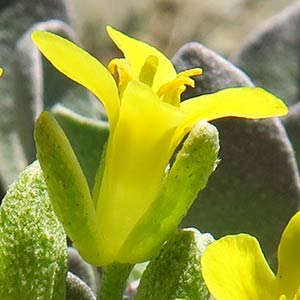Physaria alpestris
Brassicaceae tribe Physarieae
alpine twin-pod, Washington bladder-pod, Washington twin-pod
several from base, decumbent to ascending, (unbranched), 0.5–1.5 dm.
(petiole slender);
blade obovate, 3–5 cm (width 10–20 mm, base tapering abruptly to petiole), margins entire, (apex rarely slightly acute).
blade oblanceolate, 0.5–1.5 cm (width 3–5 mm), margins entire.
petiolate, sessile, or subsessile;
blade base usually not auriculate (except Paysonia), margins entire, dentate, or sinuate.
subcorymbose.
ebracteate, often elongated in fruit.
sepals oblong, 8–10 mm;
petals spatulate, 12–14 mm.
actinomorphic;
sepals erect, spreading, ascending, or reflexed, lateral pair seldom saccate basally;
petals white, yellow, lavender, purple, violet, orange, or brown [pink], claw present, often distinct;
filaments unappendaged, not winged;
pollen (3 or) 4–11-colpate.
(divaricate, straight), 5–10 mm.
didymous, mostly highly inflated (strongly flattened at least in 1/2 toward replum), 14–18 × 14–18 mm, (papery, basal sinus slightly notched, apical open, shallow);
valves (retaining seeds after dehiscence), evenly pubescent;
replum lanceolate, 7–10 mm, width 1.5–2.5 mm, as wide as or wider than fruit, apex acute to acuminate;
ovules 8–10 per ovary;
style 5–7 mm.
silicles or siliques, dehiscent, unsegmented, terete, latiseptate, or angustiseptate;
ovules 2–100 per ovary;
style usually distinct;
stigma entire or strongly 2-lobed.
flattened, (2–3 mm).
biseriate, uniseriate, or aseriate;
cotyledons accumbent or incumbent.
usually short-stalked, subsessile, or sessile, sometimes long-stalked, stellate, scalelike, subdendritic, or forked, sometimes mixed with simple ones.
= 48–52, 52, 64, 67–70.
Physaria alpestris
Brassicaceae tribe Physarieae
Genera 7, species ca. 130 (7 genera, 105 species in the flora).
(Discussion copyrighted by Flora of North America; reprinted with permission.)


